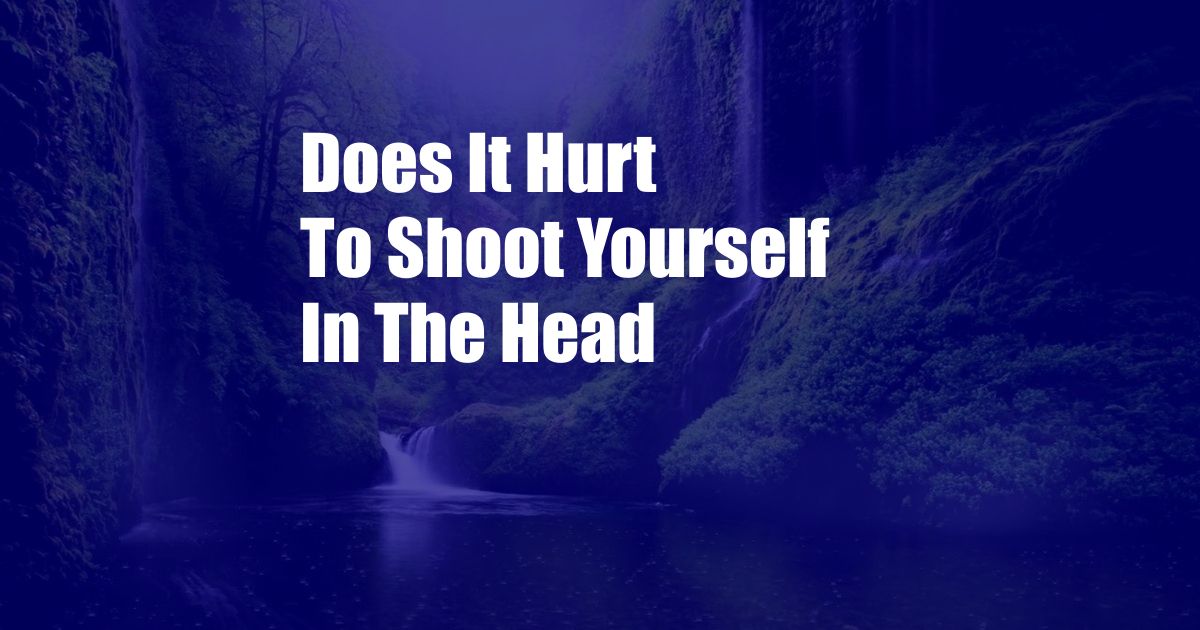
Does it Hurt to Shoot Yourself in the Head? The Terrible Toll of Suicide
In the depths of despair, the thought of ending one’s life can seem like a tempting escape. But behind the veil of suicide lies a horrific reality, a permanent solution to a temporary problem. The act of taking one’s own life is not only a tragedy for the individual but also a profound loss for their loved ones and the community as a whole.
Suicide is a complex issue with no simple answers. It is often the result of a multitude of factors, including mental health conditions, substance abuse, and life stressors. While the pain and suffering that lead to suicide are undeniable, the act itself is never the answer. There is always hope, always help available.
The Aftermath of Suicide: A Devastating Ripple Effect
The consequences of suicide extend far beyond the individual who takes their own life. Family members, friends, and the community as a whole are left to grapple with the profound loss and the unanswered questions. The ripples of grief and trauma can reverberate for generations, leaving an enduring legacy of pain.
For those left behind, suicide can shatter the very fabric of their lives. They struggle to understand why their loved one chose to end their life, and are often left with feelings of guilt, shame, and anger. The grieving process is often prolonged and fraught with challenges, as suicide survivors must navigate the complexities of their own emotions and the stigma surrounding suicide.
Understanding Suicide: A Multifaceted Perspective
Suicide is a multifaceted phenomenon that cannot be attributed to a single cause. It is often the result of a combination of factors, including:
- Mental health conditions, such as depression, anxiety, and bipolar disorder
- Substance abuse
- Life stressors, such as financial problems, relationship difficulties, or job loss
- Genetic and biological factors
- Environmental factors, such as exposure to trauma or violence
It is crucial to recognize that suicide is not a sign of weakness or a selfish act. Rather, it is a symptom of profound emotional distress and a desperate attempt to escape unbearable pain.
Warning Signs and Risk Factors: Recognizing the Call for Help
Suicide is often preceded by warning signs and risk factors. By recognizing these indicators, we can reach out to those in need and provide the help they need.
- Talking or writing about suicide or death
- Giving away possessions or making arrangements for after their death
- Increased substance abuse
- Isolation from friends and family
- Engaging in reckless or self-destructive behavior
- Extreme mood swings or changes in personality
If you or someone you know is exhibiting these warning signs, do not hesitate to reach out for help. Contact a mental health crisis hotline or a healthcare professional immediately.
Prevention and Intervention: Breaking the Cycle of Suicide
Suicide is preventable. By working together, we can create a society where those who are struggling know that they are not alone and that there is always hope.
Prevention efforts should focus on:
- Reducing the stigma surrounding mental health and suicide
- Increasing access to mental health care
- Educating the public about suicide warning signs and risk factors
- Providing support to those who have lost loved ones to suicide
Intervention is also crucial. If you suspect that someone is at risk of suicide, take immediate action:
- Talk to them directly and openly about their thoughts and feelings
- Listen without judgment and with empathy
- Encourage them to seek professional help
- Stay with them until help arrives
Conclusion: A Call to Action
Suicide is a tragedy that touches the lives of countless individuals and families. By understanding the causes and risk factors, recognizing the warning signs, and taking preventive action, we can break the cycle of suicide and create a world where everyone has the support they need to thrive.
If you or someone you know is struggling with suicidal thoughts, please reach out for help. There is always hope, and there are people who care about you and want to help.
FAQs on Does it Hurt to Shoot Yourself in the Head?
Q: What are the physical effects of shooting yourself in the head?
A: Shooting yourself in the head can cause severe brain damage, skull fractures, and facial disfigurement. It is often fatal, and if not, it can result in permanent disabilities, such as paralysis, speech impairments, and cognitive difficulties.
Q: What are the emotional effects of suicide?
A: Suicide has a devastating impact on the family and friends of the person who has died. They may experience intense grief, guilt, anger, and depression. The loss of a loved one to suicide can also have a long-term impact on the survivor’s mental health and well-being.
Q: How can I help someone who is thinking about suicide?
A: If you are concerned that someone is considering suicide, take immediate action. Talk to them directly and openly about their thoughts and feelings. Listen without judgment and with empathy. Encourage them to seek professional help, and stay with them until help arrives.
Q: Are there any warning signs that someone is at risk of suicide?
A: There are several warning signs that someone may be at risk of suicide, including: talking or writing about suicide or death; giving away possessions or making arrangements for after their death; increased substance abuse; isolation from friends and family; engaging in reckless or self-destructive behavior; extreme mood swings or changes in personality.
Q: What should I do if I think someone is about to attempt suicide?
A: If you believe that someone is about to attempt suicide, call 911 immediately. Stay with the person until help arrives, and try to keep them calm and safe.